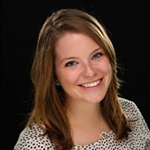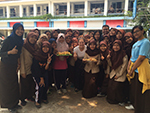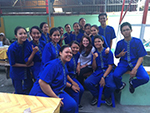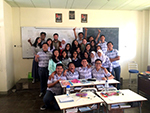
Kendra Ellen Reiser,
Class of 2015
Psychology
Kendra Reiser (class of 2015, psychology) spent her senior year of high school applying for colleges where she could find a home, a family. A place that she could return to in the decades following graduation and feel just as connected as she did when she first arrived as a freshman.
She applied to multiple colleges and universities, including Notre Dame. She received her acceptance to Notre Dame in the fall, along with an offer to be a part of the Glynn Family Honors Program. She would have to wait until spring to hear back from other schools, including her father’s alma mater. When the acceptance letter came for her father’s school, she had a big decision to make: go to a school close to her home in Seattle—one that many members of her family had attended—or go to the university two plane rides and 2,000 miles away in northern Indiana? Her parents told her to pray on it and take her time.
“One day, I woke up. I knew that I wanted to go to go Notre Dame. When I told my family, all of them responded that they already knew,” Kendra says. Ever since she had visited Notre Dame for the Glynn Family Honors Program weekend that fall, her parents could tell that it was the place for Kendra.
Kendra arrived on campus in the fall of 2011, and she spent the next four years learning and growing in the Notre Dame community. She joined the men’s rowing team as a coxswain, took interest in the leadership roles it offered, and graduated as president of the team her senior year. She worked and researched in Psychology and Education, Schooling, and Society labs on campus. She tutored at the English as a New Language Preschool through the Robinson Community Learning Center. She volunteered in Casablanca, Morocco for WorldTeach through the Kellogg Institute for International Studies in the summer of 2014. She wrote her senior thesis on English as a New Language. Through each of these activities, she defined and chased her passion.
“In high school, we were required to do a lot of community service,” Kendra reflected, “but I never really understood how that fit into a larger story. When I got to Notre Dame, it was all about pursuing opportunities that meant something something to me, and that could mean something to my future.”
Her work wasn’t focused on making herself look good on paper. She wasn’t focused on improving her résumé or making herself more appealing to graduate school admissions committees.
“If it’s important to you, do that. That’s what matters to Notre Dame: you are becoming your own person. I was provided with these amazing resources; these amazing professors and staff that really allowed me to pursue opportunities that were in line with my beliefs, my thinking, and my passions,” Kendra said.
In her junior year at Notre Dame, Kendra heard about the Center for Undergraduate Scholarly Engagement (CUSE) and the Fulbright U.S. Student Program. She had never heard of the Fulbright, but she saw a few posters about the program and began attending the information sessions CUSE offered.

She learned that the the Fulbright U.S. Student Program aims to increase mutual understanding between the people of the U.S. and other countries through exchange of persons, knowledge, and skills. She learned about the two main types of Fulbright grants: Study/Research grants and English Teaching Assistantship (ETA) grants. Applicants for the Study/Research grants design their own projects and will typically work with advisers at foreign universities, research institutes, or NGOs. Kendra, however, was more interested in the ETA.
An English Teaching Assistantship places a Fulbrighter in a classroom abroad to provide English-language learners with the benefits of interacting with a native English speaker. English Teaching Assistants (ETAs) do this while serving as cultural ambassadors for the U.S. through community engagement. The age and academic level of classroom students varies by country, ranging from kindergarten to university. Many placements do not require previous teaching or language experience.
“It could not have been a more stress-free or gradual process, in figuring out what the Fulbright was. It was very much step-by-step,” Kendra recalled about the months she worked with CUSE on her Fulbright application.
While the process lasted about nine months from pre-application to decision, Kendra wasn’t overwhelmed.
“I think if you compile it all, it would probably be really three, maybe four weeks of applying spread out over the nine months. A lot of that time was spent reading my own papers, editing, and figuring out what it meant to tell my own story,” Kendra said.
She had started working on some ideas and application essays the summer before her senior year. When she had the opportunity to sit down with CUSE early in the process, she realized that she wasn’t quite on the right track.
“CUSE got me started so early, so I was able to make mistakes. CUSE was trying to really get it right with me, making sure that me, Kendra Ellen Rieser, was coming through on paper to the people who would be awarding me with this grant. They weren’t focused on good enough. They wanted it to be quality; they wanted me to get the grant,” Kendra said.
The process soothed Kendra’s nerves. She was able to make changes and work through her mistakes. She worked with CUSE from April to October 2014, editing drafts, attending advising appointments, and finally participating in an on-campus interview. After all those months, she submitted her application, and then began to wait.

Semi-finalist decisions were announced in January 2015. Kendra’s name was on the list. She heard about the result while on a training trip with the Notre Dame Men’s Rowing Team.
“It came at a time where I didn’t have any time or energy to register what had just happened. When I heard that I was a semi-finalist, I did a ton of research to figure out what it meant. I knew that as long as the country liked me, I was in a good place. I had gotten through the hard part,” Kendra recalled.
She had made it past the U.S. Fulbright National Screening Committee, and her application would now be sent to Indonesia, the country she had applied to for her ETA.
She still had several months to wait on final decisions from Indonesia. Flash forward to another training week with the rowing team that March during Spring Break.
“On Wednesday of that week, I heard back from ACE [the Alliance for Catholic Education] that I had gotten into their program. On Thursday, I heard back from PLACE, which is a similar program to ACE but at Loyola Marymount University in California. On Friday, I heard back from the Fulbright. I was headed into one of my last practices of the week. I was about to get a big decision on whether or not I would be going to San Diego with my team that year. It was a big moment. I came running out of the hotel to get in the van and told my coach, ‘Coach! Coach! I’m a Fulbright! I actually got it!’ But I didn’t quite process what had happened until after I also received the news that I was going to get to go to San Diego. It was one of the best weeks of my life,” Kendra recalled.
Kendra had a few months to get ready. Much of her preparation for her Fulbright grant came through reading. She read about the education system in Indonesia. She read every blog that had ever been written by an ETA in Indonesia (and there are many). It was vital to her preparation. She spent time on Fulbright’s web site, looking through the directory of past Fulbright ETAs in Indonesia. Through Facebook and email, she was able to connect with many of them and ask them questions. Before she knew it, it was time to board a plane to Indonesia.

“It took forever to get there. I left on August 21st, and I arrived on the morning of August 23rd. Indonesia is 12 hours ahead of South Bend. The American-Indonesian Exchange Foundation was really important in bringing all of the ETAs into the country at the same time. We spent one night in Jakarta together. We then went directly to our sites for a week—no language experience whatsoever. No clue what what we were getting into. No orientation,” Kendra said about her arrival.
While it sounds scary, Kendra believes that this was a very important part of her experience. Going straight to her site gave her the opportunity to realize what she would need from orientation, which would happen the following week, and what kinds of questions she would want to ask.
Kendra’s site was located in Yogyakarta, Indonesia, in the region of Daerah Istimewa Yogayakarta. It’s informally known as Jogja. Her school, SMK Negeri 6 Yogyakarta, is a hospitality school for high schoolers learning about culinary and pastry arts, hotel management and travel industries, sewing and design, and beauty and cosmetics.
“The whole first week was kind of a blur. But in that blur, I could see smiles, and I could see passion, and I could see family. Those were three things that I knew would make my year great. Smiles, passion, family. That it Jogja. That is my school,” Kendra said.

Her first week at school, she spent time observing teachers and meeting students. It was very informal. After that introductory week, she headed off to Fulbright orientation in Bandung.
“Orientation was the most intense two weeks of my life. We had four hours of language training every day, and the rest of the time we got pedagogical training. The best part was the language training. Everyone was so eager to learn. They brought in some of the best teachers for Bahasa Indonesia. They split us into classes based on ability. We got small intimate classes, got a ton of experience.”
Other than a few podcasts, Kendra had no experience with the language before leaving the U.S.
“I can say with confidence that, at this point, I speak pretty well. It’s a language that is very easy to pick up, but it also requires you to just listen to teachers and native speakers. You pick up so much,” Kendra said.
Those two weeks of training at orientation were crucial to Kendra’s language acquisition, and since then her proficiency has greatly improved. She can now tell stories in the language and even make people laugh.
“Being able to use humor in a language that’s not your own is a really cool thing,” Kendra said.
The language that’s spoken at her school is more informal than what she spent two intensive weeks learning at orientation.
“It’s not Bahasa Indonesia, it’s Bahasa Jawa. I’ve had this amazing exposure to the local language. Which is hard. But it’s amazing. It’s my favorite thing to learn that language. Now I’m able to speak a combination of Indonesian and Javanese, which I’m proud of,” said Kendra.

After orientation, Kendra went back to Jogja. She started school on a Monday, the day of her school’s weekly flag-raising ceremony. At the ceremony she was formally introduced to the community, and she began her work.
Kendra is a co-teacher. She partners with other instructors at the school, teaching English every day to 10th or 11th graders.
“A lot of what I’m focusing on this semester is not just doing typical activities and games. This semester I really want to do engaging activities, making my own worksheets and that type of thing. The first semester was really useful in just being there, getting to know the students, being present,” Kendra said.
She wants to focus on what she can do to make sure the students leave with a substantial amount of English-language proficiency. Her 11th graders from her first semester of teaching are off doing practical work in industries, such as hotels and restaurants, where English language ability can help them excel in their positions.
“My students are really driven. I really value the fact that I’m at a vocational high school. Everything that they do has a meaning to them, because it’s going to be their job. It’s not like they’re just learning some generic subject that they know they’re never going to use. All the things they are learning are very useful to them in their lives and their livelihood. So they’re engaged. They’re super engaged students. It’s very easy to get them involved in class,” Kendra said.
Since SMKN 6 Yogyakarta specializes in hospitality, Kendra has some perks. She stays in a “mock-up” hotel room used by the accommodations students, buys food from the culinary students when they sell their meals, gets her new Batik shirts tailored for free by the fashion students, and learns the inside scoop on the best places to visit in Indonesia from the travel students.
Kendra did have to adjust to a culture that is much more indirect than American culture. Everything is passive, and she sometimes has to read behind people’s words to grasp the true meaning of a situation.
“Americans are not passive. We’re coming from a very independent culture, a very individualistic culture. That’s an unexpected challenge: how difficult it is to navigate people who don’t say exactly what they want,” Kendra reflects.
Jogja is a big city, about half-a-million people, and Kendra has all sorts of opportunities there when she is not teaching.

“I like going to find very local things to do. I like to try new foods. I like finding places to buy fruit. I like to practice my Bahasa Indonesia,” Kendra said.
Parades are also regular occurrences in Jogja, so Kendra has many opportunities to observe community celebrations.
“There are a lot of events with the Sultan. Recently the Sultan’s deputy governor passed away. So the next person in line came into power and there was a big parade for that. For Jogja’s birthday—big parade for that,” said Kendra.
She’s been to concerts at universities. She’s even given informal presentations at universities about teaching English. She’s visited other high schools in the area. She still goes to language class on Wednesdays and Thursdays. And she travels.
“It’s more like exploring new places,” says Kendra. “We will go to a bunch of different beaches. But it’s a journey to get there. You’re using a motorbike. You’re passing beautiful rice fields. You can stop at any point and climb into a temple.”
Kendra also loved her trip to Flores Island. It’s a “yet-to-be-explored” island. She saw wild komodo dragons and climbed a volcano spotted with polychromatic, mineral-suffused lakes. It’s so different from her life in Seattle.
As Kendra reflects on her time in Indonesia, she has only good things to say.

“There’s something that’s very, very special about becoming part of a family, that’s not a family that speaks your language. It’s very special to become a part of a culture. And it’s not one of those things that I take for granted. I look a certain way here that’s interesting and different. It’s getting to the point where you know that they’re not just interested in you because you’re different. They’re interested in you because you have become a friend, a trusted member of the community. What you say matters now. That has been one of the absolute best part of my grant. Getting to the point with my fellow teachers here where they’re my family and I can go to their homes, meet their children. That’s been absolutely incredible. If I left her without having traveled one foot outside of Jogja, I still would’ve been happy with the fact that it meant that I could become part of their community, speak their language. The best part of the Fulbright grant is that it offers you the opportunity to get to know a culture in a very intimate way, and specifically the English Teaching Assistantship allows you to connect very directly with a community and have a very important, significant, and immediate impact on the people. It’s inexplicably rewarding.”
Kendra told herself that when she came to Indonesia, she would immerse herself in the culture and not obsess about what comes next year. Kendra wanted to focus on her experience in Indonesia. She may pursue graduate school. She might look into the Peace Corps. She will worry about the future when her present isn’t quite so rewarding.
Kendra’s best advice for undergrads thinking about applying for a Fulbright grant is to work closely with CUSE.
“CUSE is why I got this grant. Although they did not do the things in my life that I was able to put on paper, CUSE allowed me to figure out how to communicate my story. When I was doing that alone, it didn’t come out well. The application process for the Fulbright is worth it in and of itself, just so that you learn certain things about yourself that you never put together before. Even if I didn’t get to go to Indonesia this year, the process of applying allowed me to critically think about who I am, what I want, my story, my narrative, and my passions. That was worth it, because that was never something that an application had asked me to do as thoroughly as the Fulbright application. I’m very happy.”
Kendra was one of a record 14 Fulbright Students from Notre Dame for 2015-16. Notre Dame undergraduates and undergraduate alumni interested in the Fulbright should connect with CUSE. Graduate students and graduate alum will work with the Graduate School Office of Grants and Fellowships. General information on the Fulbright U.S. Student Program is available at its website.
To learn more about Kendra’s time in Indonesia, visit her blog.
Learn more about how you can support CUSE’s efforts related to undergraduate research and national fellowships and help students and alumni like Kendra.
Originally published by Kathleen Schuler at cuse.nd.edu on February 10, 2016.